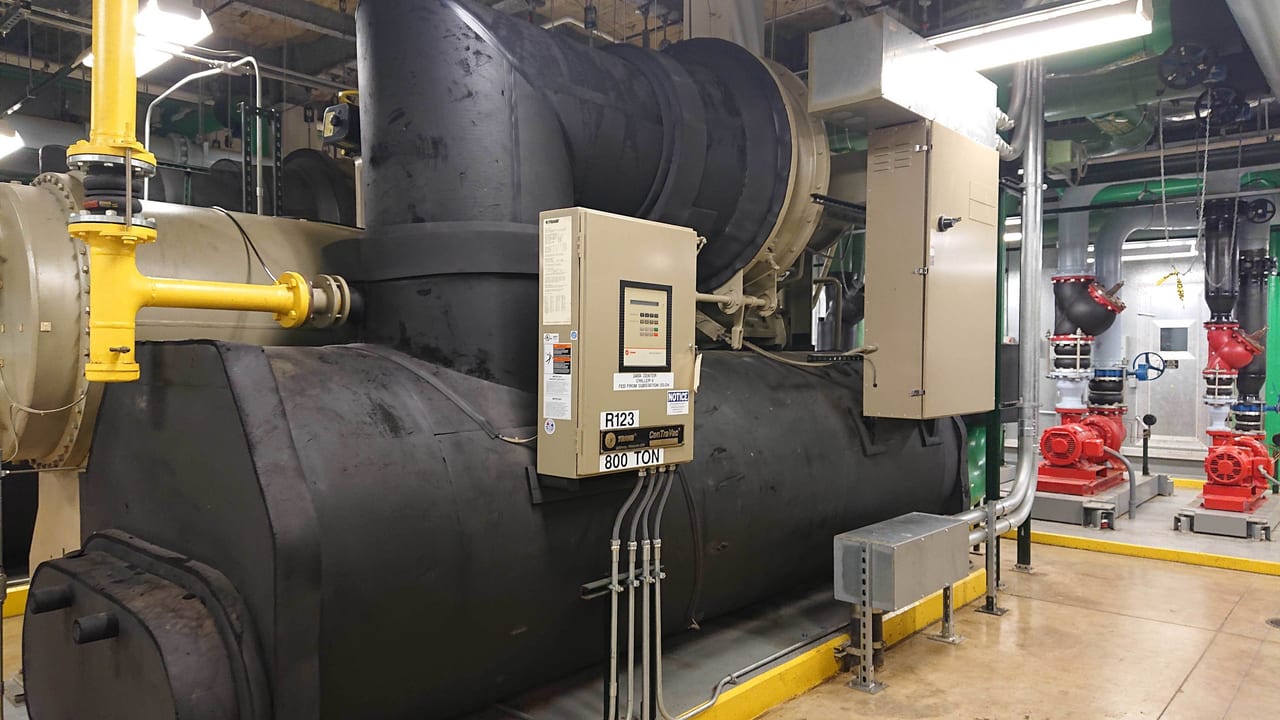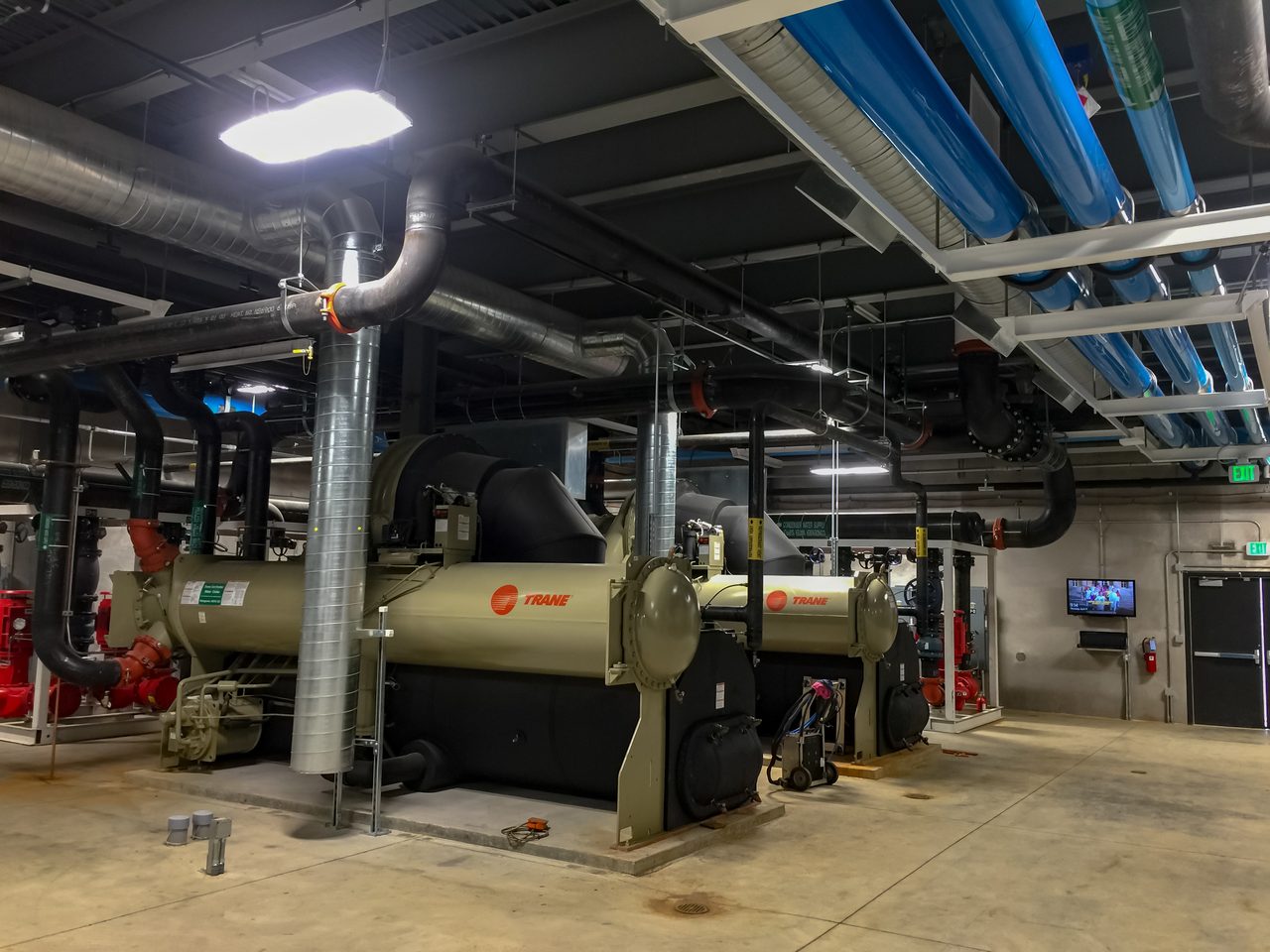

feature
Charging Forward — But Which Way Do We Go?
The greatest impact HVAC systems have on global warming and greenhouse gas emissions is from energy consumption, not the refrigerant fluid in the system.
On Sept. 26, 2016, the U.S. Environmental Protection Agency (EPA) announced that, under its Significant New Alternatives Policy (SNAP) program Rule 21, specific refrigerants, including R-134a and R-410A, can no longer be used in new chillers, effective Jan. 1, 2024. This is not to be confused with our other government use of the SNAP acronym (Supplemental Nutrition Assistance Program), but I digress.
Then, in 2017, Mexichem Fluor Inc. v. EPA complicated these rules and how their hydrofluorocarbon (HFC) bans apply by filing suit.
On April 5, 2019, the Washington, D.C., Circuit Court struck down regulations restricting the use of HFCs in certain products under SNAP. The court held that it was bound by its prior decision regarding SNAP Rule 20 (Mexichem I) in the case before it concerning SNAP Rule 21 (Mexichem II) based on the legal doctrine of issue preclusion (see Mexichem Fluor Inc. v. EPA, No. 17-1024 [D.C. Cir. Apr. 5, 2019]). So, there was an apparent reprieve for a time.
Following this, in December 2020, the American Innovation and Manufacturing (AIM) Act of 2020 was enacted, which gives the U.S. EPA new authorities to address HFCs. The AIM Act, which was signed into law on Dec. 27, 2020, directs the EPA to establish production and consumption phasedown limits that are consistent with the Kigali amendment.
Unfortunately, the SNAP website provides no clarification nor footnote to these rules, their enforcement, or validity. They have simply moved forward with issuing Rule 23 as a final rule.
As you may already know, amid the above series of events from the past few years regarding SNAP Rules 20 and 21, numerous states — many a part of the U.S. Climate Alliance — adopted the HFC bans into their own state regulations, including California, Colorado, Connecticut, Maryland, New Jersey, New York, Vermont, Virginia, and Washington. California even one-ups the SNAP Rule 21 deadline by imposing a restriction deadline of Jan. 1, 2022, on some refrigerants. On Dec. 10, 2020, California became the first state in the nation to adopt regulations that phasedown the use of HFC refrigerants in commercial and industrial stationary refrigeration units, such as those used by large grocery stores as well as commercial and residential air conditioning equipment. The brilliance of the California Air Resources Board (CARB), which approved the new rules, determined they were necessary to meet the state’s mandate to reduce HFC emissions 40% below 2013 levels by 2030. Similar thinking is seen in their voter approval of California Prop 12, the Farm Animal Confinement Initiative, such that they may soon be without any meals with bacon, but, again, I digress.
Under these new rules, starting in 2022, there is a 150-GWP limit for new or fully remodeled facilities that utilize commercial refrigeration equipment containing more than 50 pounds of refrigerant; there are varying requirements for existing facilities. The 750-GWP limit for many types of air conditioning equipment was pushed back to 2025, while variable refrigerant flow (VRF) system manufacturers have until 2026 to comply with the new limit.
European Regulation (EC) No. 517/2014 limits Difluoromethane R-32 in systems with a load of 3 kg (6.61 pounds) as of Jan. 1, 2025.
The International Code Council (ICC) has launched its “Code on a Mission” challenge, which aims to have more than one-third of the U.S. population update their building energy codes to meet or exceed the requirements of the 2021 International Energy Conservation Code by the end of 2023. In the meantime, The ICC is currently accepting code change proposals for the development of its 2024 International Energy Conservation Code (IECC) and Chapter 11 of the International Residential Code (IRC).
Since Missouri is one state in the nation that hasn’t adopted a statewide building code, it is left up to municipalities to adopt some version. The state’s reasoning in this approach is that the municipalities are responsible for enforcement of the codes, so they should choose which codes they adopt. Building code update cycles occur every three years and adoption typically takes six years or more. The goal of reducing this lag to less than two years may be a challenge, but the hope is to help the planet. Some municipalities enforce the 2009 codes, and a few rural areas have no enforcement at all. Many of the St. Louis area municipalities have adopted the 2015 International Codes, and a few have adopted the 2018 codes. The 2015 IECC references ASHRAE Standard 90.1-2013, while the 2021 IECC references ASHRAE 90.1-2019.
In a Climate Zone 4A area, a building installing a 200-ton air-cooled chiller would need an EER rating integrated part load value (IPLV) of >14.000 Btu/Wh by Standard 90.1-2013 with installation after Jan. 1, 2015, (up from >12.750 Btu/Wh for installations after Jan. 1, 2010) but requires an EER rating IPLV of >14.000 Btu/Wh for design energy cost method or >16.1 Btu/Wh for an energy cost budget method. This is a 15% increase in operating efficiency.
I still have a special liking to R-123, which is a hydrochlorofluorocarbon (HCFC), ASHRAE Class B1, and was a replacement for the chlorofluorocarbon (CFC) R-11. A now restricted refrigerant (no new equipment can use R-123), it is always nice to walk into a mechanical room where you hear the sound of the hydronic pumps but not the chiller because of the low pressure or vacuum operation of this refrigerant. New high-pressure refrigerants may have screaming screw chillers to achieve the high lift requirements to develop the needed cooling. The medium- and high-pressure chillers have a greater propensity for refrigerant leaks or discharges to atmosphere.

FIGURE 1: An R-123 water-cooled centrifugal chiller.
Images courtesy of McClure Engineering
There are those around the world who have accused the U.S. industry of being too cautious and slow in this refrigerant transition, but it is necessary to take the safe use of these refrigerants seriously and to make sure domestic equipment manufacturers and industry technicians have the time and knowledge to test and adjust to the new requirements. Selections for new refrigerants are still settling in the market. A recent inquiry with one vendor found that they are not yet offering the replacement refrigerants in the U.S. market, even though they are delivering new machines overseas.
A recent selection with another vendor for an air-cooled chiller application found the new air-cooled chiller would use a hydrofluoroolefin (HFO) R-513A — an azeotropic blend of HFO-1234yf and R-134a and an A1 refrigerant — to replace the previous option with R-134a refrigerant. The new selection showed a 6% improvement in operating efficiency and just meets the ASHRAE Standard 90.1 efficiency requirements while being developed under the 2016 standard requirements. A review of recommended maintenance and service inspections found there is little or no difference in the recommended service.
This may not always be the case with the new refrigerants. R-410A alternatives present the greatest challenge to the HVAC industry, given the fact that many of the new low-GWP refrigerant replacements, such as R-454B, R-32, and R-290 (propane), are flammable A2L- or A3-rated refrigerants. The new refrigerants may be safer than R-410A, as they may have the potential to create less hydrogen fluoride gas when burned — not that anyone is burning their refrigerant at $12.80 per pound! Initial studies indicate that new equipment designed with R-32 or R-454B may have efficiency gains and that the charge quantity may be reduced as well. An 8-ounce can of R-290 (propane and refrigerant formerly known as -22A) is the equivalent of one 12-ounce can of R-22. R-290 operates at lower head pressures and offers colder air and improved performance compared to R-22.
R-1234ze(E) is an alternative for R-134a in ultralow-GWP (<10) applications but requires compressor and chiller design changes to obtain the same capacity.
R-1233zd(E), which is a low-pressure fluid that is similar in performance to R-11, has the advantage of slightly higher pressures, so customers will end up with American Society of Mechanical Engineers (ASME)-designed and constructed pressure vessels and an A1 refrigerant. This might be the preferred alternative for low-pressure centrifugal chillers.
R-514A is a low-pressure refrigerant that offers similar efficiency and lower capacity when compared to R-123; however, it is a higher-toxicity (B1) refrigerant.
The greatest impact HVAC systems have on global warming and greenhouse gas emissions is from energy consumption, not from the refrigerant fluid in the system. Some new refrigerants may be better for the environment but not all. Some new refrigerants may be more efficient but not all. New chillers and unitary air conditioners may have a higher first cost for equipment, the lubricant, and the refrigerant.

FIGURE 2: A heat recovery chiller installed in 2007 saves approximately $1,500 per day.
The A2L refrigerants require a factory set and sealed sensor with no field adjustment permitted to monitor leak detection and activate at the 25% lower flammability limit for household and similar electrical appliances to meet UL/CSA 60335-2-40. These sensors must also respond in less than 30 seconds.
R-717 ammonia (NH3) and R-744 carbon dioxide (CO2) are other available options, but they are not often pursued. Ammonia is toxic and corrosive, and when mixed with air in the 16%-25% range, it can cause a large explosion. Carbon dioxide, because of its high pressure (about 640 psig at 50°F and 1,030 psig at 86°F), is heavier than air asphyxiant and has potential for freeze burns and the formation of dry ice.

FIGURE 3: An R-717 ammonia chiller.
SNAP Rule 23, published in the Federal Register on May 6, 2021, is listed as a final rule; however, it reads more like a discussion with a lack of clarity and straightforward direction. Its language reads of he-said-she-said-style commentary, and, in some cases, it appears that the EPA or Environmental Investigation Agency (EIA) just ended the discussion.
The EIA notes that a proposal to modify UL 60335–2–89 is being considered. The proposal would allow up to 500 grams of R–290 (propane) or 13 times the lower flammability limit (LFL) of other A3 refrigerants, such as R–600a (Isobutane).1
Equipment must have distinguishing red (Pantone® Matching System [PMS] #185 or RAL 3020) color-coded hoses and piping to indicate use of a flammable refrigerant. The air conditioning equipment shall have marked service ports, pipes, hoses, and other devices through which the equipment’s refrigerant circuit is serviced. Markings shall extend at least 1 inch (25 mm) and shall be replaced if removed.1 (I am not clear if this requirement applies to only A3 refrigerants or if it also applies to A2L refrigerant systems.)
The EPA previously listed R-32 as an acceptable refrigerant for some types of residential and light commercial air conditioning and heat pump end-use categories, specifically self-contained room air conditioners, such as window units, packaged terminal air conditioners (PTACs), packaged terminal heat pumps (PTHPs), portable room A/C units, and wall-mounted A/C units (80 FR 19454, April 10, 2015). As noted in the 2020 Notice of Proposed Rulemaking (NPRM), this action adds a listing for this substitute to include rooftop units, ground-source heat pumps (GSHPs), water-source heat pumps (WSHPs) — which are typically self-contained but not sized for a single room — and various types of split systems.1
When selecting equipment, one must know the system of units (SI) because capacity is often only listed in kW instead of the IP Btu/Wh or tons of cooling. This is because other countries, mainly in Europe, pushed ahead with refrigerant restrictions faster than manufacturers could come up with acceptable replacements and new equipment. Some refrigerant blends may have a significant glide (the refrigerant changes state over a range of temperatures), which may limit their use in split systems or at least limit the length of allowable tubing between the condensing unit and the evaporating coil.
Care in maintenance and cleaning will be another consideration and understanding. The direct, free-cooling option circuit for one air-cooled chiller consists of copper; carbon steel; cast iron; zinc; EPDM rubber; brass; and aluminum AA3102, AA3003, and AA4045, in addition to other materials that may be in the building loop connected to the chiller. The inhibited glycol solution should be selected at desired concentrations to ensure adequate inhibitor content. Glycol fluid should be free from foreign solid particles.
Microchannel condenser coils have specific restrictions when cleaning. Sprayer nozzle pressure should not exceed 580 psi, and the maximum source angle should not exceed 25 degrees to the face of the coil. A 15-degree fan spray pattern nozzle should be used and held 1-3 inches off the face of the microchannel coil. The coils are delicate and deep compared to old finned-tube coils. Microchannel coils are not easily repaired. Where we were once reluctant to specify enhanced coils or tubes in fear of capacity loss due to fouling, we are now coming up with many ways to enhance performance to improve efficiency and meet the latest efficiency targets.
Recommended maintenance from one air-cooled chiller manufacturer: Perform all maintenance procedures and inspections at the recommended intervals.
Weekly
Check pressure for evaporator, condenser, and intermediate oil;
Observe liquid line sight glass on the electronic expansion valve (EXV). If the liquid line sight glass has bubbles, measure the subcooling entering the EXV. Subcooling should always be greater than 10°F;
Inspect the entire system for unusual operation;
Inspect the condenser coils for dirt and debris. Clean if the coils are dirty; and
Ensure the exterior of the panel enclosures (including remote variable frequency drive [VFD], if installed) are clear of any dust or debris.
Monthly
Perform all weekly maintenance procedures;
Record the system subcooling;
Record the system superheat; and
Make any repairs necessary.
Annually
Perform all weekly and monthly procedures;
Check the oil level while the unit is off. (This requires 40 minutes of run time with the load at or near full load. Then, shut off the system and wait 30 minutes to observe the level (wait four hours if adjusting oil) In total, this is a five-hour effort;
Routine changing of the oil is not required;
Make an oil analysis to determine the condition of the oil. Have a qualified laboratory perform a compressor oil analysis to determine system moisture content and acid level;
Contact a qualified service organization to leak-test the chiller, check operating and safety controls, and inspect the electrical components for deficiencies;
Clean and repaint any areas that show signs of corrosion;
Clean the condenser coils, at minimum, once each year — more if the unit is located in a “dirty” or corrosive environment. Sprayer nozzle pressure should not exceed 580 psi;
Clean the air filters in the bottom inlet hoods that extend from the back of the electrical panel. Consider installing a potassium permanganate (KMnO4) or activated carbon bag in the control cabinet and changing it annually to prevent corrosives in the control cabinet;
Check and tighten all electrical connections, as necessary; and
Clean propylene glycol water strainers – If differential pressure reaches 5-10 psi, the screen must be cleaned. A recent selection had a chiller pressure drop of 23.3 feet head design (10.1 psi).

FIGURE 4: A clean water-cooled chiller plant.
From a June article in Joule magazine, titled, “U.S. building energy efficiency and flexibility as an electric grid resource,” it was said: “Co-deployment of building efficiency and flexibility yields the largest load impacts. Up to 800 terawatt-hours (TWh) generation and 208-GW daily net peak demand could be avoided. Preconditioning and plug load management are among the most impactful measures.
"Across regions in 2050, full electrification of U.S. building loads at a baseline efficiency level adds 1,081 TWh to annual electricity use and 231 GW and 64 GW to daily net winter and summer peak demand, respectively, of which 337 TWh (31%), 101 GW (44%), and 29 GW (45%) is avoided by co-deployment of best available efficiency and flexibility,” the article continues.
“The so-called demand-side of electricity is electricity that is used in homes and workplaces, such as for air conditioning, water heating, and powering lights and appliances. The researchers approached this electricity use from buildings as a grid resource by increasing the efficiency and flexibility of buildings’ electricity use, such as by operating higher-performing equipment and shifting the time when its usage takes place, they found this resource to be substantial, avoiding up to 742 terawatt-hours (TWh) of annual electricity use and 181 gigawatts (GW) of daily net peak load in 2030, rising to 800 TWh and 208 GW by 2050.”2
(Total U.S. electricity consumption in 2020 was about 3,800 TWh.)
Other publications of interest and particularly valuable to your knowledgebase:
AHRI Standard 700-2019, “Specification for Refrigerants,” is a good reference, but it does not include all new refrigerants. AHRI has other valuable information and training aids.
ASHRAE Standard 15 and 34, “Safety Standard for Refrigeration Systems and Designation and Safety Classification of Refrigerants.”
The EPA’s Substitute for Centrifugal Chillers has a list of acceptable and unacceptable refrigerants for centrifugal chillers.
The EPA’s Substitutes in Positive Displacement Chillers has a list of acceptable and unacceptable refrigerants for positive displacement chillers.
The EPA’s Substitutes in Industrial Process Refrigeration has a list of acceptable and unacceptable refrigerants for industrial process refrigeration. Review all options when selecting and designing chiller plants and cooling equipment. The market is still playing out. Focus on the energy and make good choices.
Footnotes:
Federal Register / Vol. 86, No. 86 / Thursday, May 6, 2021 / Rules and Regulations: 40 CFR Part 82 https://www.govinfo.gov/content/pkg/FR-2021-05-06/pdf/2021-08968.pdf
Langevin et al., US building energy efficiency and flexibility as an electric grid resource, Joule (2021), https://doi.org/10.1016/j.joule.2021.06.002

Chuck Dale-Derks, P.E.
Chuck Dale-Derks, P.E., is a principal at McClure Engineering, a mechanical and electrical consulting engineering firm dedicated to the development of innovative solutions to unique engineering problems.
Lead image courtesy of Pixabay
